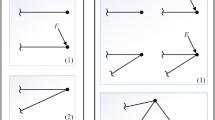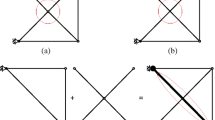Abstract
A new method called the growing ground structure method is proposed for truss topology optimization, which effectively expands or reduces the ground structure by iteratively adding or removing bars and nodes. The method uses five growth strategies, which are based on mechanical properties, to determine the bars and nodes to be added or removed. Hence, the method can optimize the initial ground structures such that the modified, or grown, ground structures can generate the optimal solution for the given set of nodes. The structural data of trusses are manipulated using C++ standard template library and the Boost Graph Library, which help alleviate the programming efforts for implementing the method. Three kinds of topology optimization problems are considered. The first problem is a compliance minimization problem with cross-sectional areas as variables. The second problem is a minimum compliance problem with the nodal coordinates also as variables. The third problem is a minimum volume problem with stress constraints under multiple load cases. Six numerical examples corresponding to these three problems are solved to demonstrate the performance of the proposed method.
Similar content being viewed by others
References
Achtziger W (2007) On simultaneous optimization of truss geometry and topology. Struct Multidisc Optim 33:285–304
Achtziger W, Bendosoe M, Ben-Tal A, Zowe J (1992) Equivalent displacement based foumulation for maximum strength truss topology design. Impact Comput Sci Eng 4:314–345
Bendsøe MP, Sigmund O (2003) Topology optimization. Springer, Berlin Heiderberg New York
Boost (2007) Boost C++ library http://boost.org/
Cheng GD, Guo X (1997) ε-relaxed approach. Struct Multidisc Optim 29:190–197
Dorn W, Gomory R, Greenberg H (1964) Automatic design of optimal structures. J Mec 3:25–52
Gill PE, Murray W, Saunders M (1997) User’s guide for SNOPT version 7 software for large-scale nonlinear programming. Stanford Business Software, Mountain View
Kirsch U (1993) Fundamental properties of optimal topologies. In: Bendsoe MP (ed) Topology optimization of structures. Kluwer, Norwell, pp 3–18
Kirsch U (1996) Integration of reduction and expansion processes in layout optimization. Struct Optim 11:13–18
Kirsch U (2002) Design-oriented analysis of structures. Kluwer, Norwell
Martinez P, Marti P, Querin OM (2007) Growth method for size, topology, and geometry optimization of truss structures. Struct Multidisc Optim 33:13–26
Mckeown JJ (1998) Growing optimal pin-jointed frames. Struct Optim 15:92–100
Meyers S (2002) Effective STL. Addison Wesley, Reading
Ohsaki M (1998) On simultaneous optimization of topology and geometry of a regular plane truss. Comput Struct 79(6):673–679
Ohsaki M (2001) Random search method based on exact reanalysis for topology optimization of trusses with discrete cross-sectional areas. Comput Struct 66(1):69–77
Ohsaki M, Katoh N (2005) Topology optimization of trusses with stress and local constraints on nodal stability and member intersection. Struct Multidisc Optim 29:190–197
Pedersen P (1972) On the optimal layout of multi-purpose trusses. Comput Struct 2:695–712
Reddy G, Cagan J (1994) An improved shape annealing algorithm for truss topology generation. ASME J Mech Eng 117:315–321
Rule WK (1994) Automatic design by optimized growth. ASCE J Struct Eng 120:3063–3070
Siek JG, Lee LQ, Lumsdaine A (2002) The boost graph library. C++ in-depth series. Addison Wesley, Reading
Stolpe M, Svanberg K (2001) On the trajectories of the epsilon-relaxation approach for stress-constrained truss topology optimization. Struct Multidisc Optim 21:140–151
Stolpe M, Svanberg K (2004) A stress-constrained truss-topology and material-selection problem that can be solved by linear programming. Struct Multidisc Optim 27:126–129
West DB (2001) Introduction to graph theory, 2nd edn. Prentice Hall, Englewood Cliffs
Author information
Authors and Affiliations
Corresponding author
Rights and permissions
About this article
Cite this article
Hagishita, T., Ohsaki, M. Topology optimization of trusses by growing ground structure method. Struct Multidisc Optim 37, 377–393 (2009). https://doi.org/10.1007/s00158-008-0237-4
Received:
Revised:
Accepted:
Published:
Issue Date:
DOI: https://doi.org/10.1007/s00158-008-0237-4




